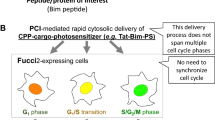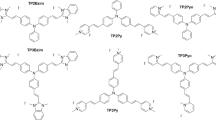Abstract
In this study, we provide evidence that photostimulation of various cancer cells preloaded with a new photosensitizing compound, tetrakis-meso-(4-ethyleneglycol-2,3,5,6-tetrafluorophenyl) porphyrin (PORF-TEG), results in rapid activation of the cell death machinery. PORF-TEG, although primarily localized in lysosomes, induces mitochondria-driven apoptosis. The induction of apoptosis is accompanied by immediate and sustained activation of p38 mitogen-activated protein kinase (MAPK) and transient activation of c-Jun N-terminal kinase (JNK). Conversely, the inhibition of p38 by PD 169316 or SB202190 and by the p38α dominant-negative mutant as well as the deletion of the p38α gene (MEFs-KO) protected cells from apoptosis, whereas inhibition of JNK did not. Activation of the p38 signaling pathway occurs upstream of caspase activation. In addition, preincubation of cells with scavengers of reactive oxygen species attenuated p38 and caspase activation and increased cell survival, thus connecting reactive oxygen species formation with the activation of the p38 pathway. Later events included degradation of Bcl-2, activation of tBid, and cleavage of Bad and Mcl-1. The data suggest a key role for p38 MAPK in PORF-TEG-photoinduced apoptosis.
This is a preview of subscription content, access via your institution
Access options
Subscribe to this journal
Receive 50 print issues and online access
$259.00 per year
only $5.18 per issue
Buy this article
- Purchase on Springer Link
- Instant access to full article PDF
Prices may be subject to local taxes which are calculated during checkout







Similar content being viewed by others
References
Ahmad N, Gupta S, Feyes DK, Mukhtar H . (2000). Involvement of Fas (APO-1/CD-95) during photodynamic-therapy-mediated apoptosis in human epidermoid carcinoma A431 cells. J Invest Dermatol 115: 1041–1046.
Almeida RD, Manadas BJ, Carvalho AP, Duarte CB . (2004). Intracellular signaling mechanisms in photodynamic therapy. Biochim Biophys Acta 1704: 59–86.
Assefa Z, Vantieghem A, Declercq W, Vandenabeele P, Vandenheede JR, Merlevede W et al. (1999). The activation of the c-Jun N-terminal kinase and p38 mitogen-activated protein kinase signaling pathways protects HeLa cells from apoptosis following photodynamic therapy with hypericin. J Biol Chem 274: 8788–8796.
Bae J, Leo CP, Hsu SY, Hsueh AJ . (2000). MCL-1S, a splicing variant of the antiapoptotic BCL-2 family member MCL-1, encodes a proapoptotic protein possessing only the BH3 domain. J Biol Chem 275: 25255–25261.
Callsen D, Brune B . (1999). Role of mitogen-activated protein kinases in S-nitrosoglutathione-induced macrophage apoptosis. Biochemistry 38: 2279–2286.
Condorelli F, Salomoni P, Cotteret S, Cesi V, Srinivasula SM, Alnemri ES et al. (2001). Caspase cleavage enhances the apoptosis-inducing effects of BAD. Mol Cell Biol 21: 3025–3036.
De Chiara G, Marcocci ME, Torcia M, Lucibello M, Rosini P, Bonini P et al. (2006). Bcl-2 Phosphorylation by p38 MAPK: identification of target sites and biologic consequences. J Biol Chem 281: 21353–21361.
Granville DJ, Carthy CM, Jiang H, Shore GC, McManus BM, Hunt DW . (1998). Rapid cytochrome c release, activation of caspases 3, 6, 7 and 8 followed by Bap31 cleavage in HeLa cells treated with photodynamic therapy. FEBS Lett 437: 5–10.
Granville DJ, Jiang H, An MT, Levy JG, McManus BM, Hunt DW . (1999). Bcl-2 overexpression blocks caspase activation and downstream apoptotic events instigated by photodynamic therapy. Br J Cancer 79: 95–100.
He J, Agarwal ML, Larkin HE, Friedman LR, Xue LY, Oleinick NL . (1996). The induction of partial resistance to photodynamic therapy by the protooncogene BCL-2. Photochem Photobiol 64: 845–852.
Henderson BW, Dougherty TJ . (1992). How does photodynamic therapy work? Photochem Photobiol 55: 145–157.
Hibi M, Lin A, Smeal T, Minden A, Karin M . (1993). Identification of an oncoprotein- and UV-responsive protein kinase that binds and potentiates the c-Jun activation domain. Genes Dev 7: 2135–2148.
Hishita T, Tada-Oikawa S, Tohyama K, Miura Y, Nishihara T, Tohyama Y et al. (2001). Caspase-3 activation by lysosomal enzymes in cytochrome c-independent apoptosis in myelodysplastic syndrome-derived cell line P39. Cancer Res 61: 2878–2884.
Hsieh YJ, Wu CC, Chang CJ, Yu JS . (2003). Subcellular localization of Photofrin determines the death phenotype of human epidermoid carcinoma A431 cells triggered by photodynamic therapy: when plasma membranes are the main targets. J Cell Physiol 194: 363–375.
Ichinose S, Usuda J, Hirata T, Inoue T, Ohtani K, Maehara S et al. (2006). Lysosomal cathepsin initiates apoptosis, which is regulated by photodamage to Bcl-2 at mitochondria in photodynamic therapy using a novel photosensitizer, ATX-s10 (Na). Int J Oncol 29: 349–355.
Ishisaka R, Kanno T, Akiyama J, Yoshioka T, Utsumi K, Utsumi T . (2001). Activation of caspase-3 by lysosomal cysteine proteases and its role in 2,2′-azobis-(2-amidinopropane)dihydrochloride (AAPH)-induced apoptosis in HL-60 cells. J Biochem (Tokyo) 129: 35–41.
Kagedal K, Zhao M, Svensson I, Brunk UT . (2001). Sphingosine-induced apoptosis is dependent on lysosomal proteases. Biochem J 359: 335–343.
Kessel D, Luo Y, Deng Y, Chang CK . (1997). The role of subcellular localization in initiation of apoptosis by photodynamic therapy. Photochem Photobiol 65: 422–426.
Kessel D, Luo Y, Mathieu P, Reiners Jr JJ . (2000). Determinants of the apoptotic response to lysosomal photodamage. Photochem Photobiol 71: 196–200.
Kessel D . (2002). Relocalization of cationic porphyrins during photodynamic therapy. Photochem Photobiol Sci 1: 837–840.
Kim TH, Zhao Y, Barber MJ, Kuharsky DK, Yin XM . (2000). Bid-induced cytochrome c release is mediated by a pathway independent of mitochondrial permeability transition pore and Bax. J Biol Chem 275: 39474–39481.
Klotz LO, Fritsch C, Briviba K, Tsacmacidis N, Schliess F, Sies H . (1998). Activation of JNK and p38 but not ERK MAP kinases in human skin cells by 5-aminolevulinate-photodynamic therapy. Cancer Res 58: 4297–4300.
Kralova J, Dvorak M, Kral V . (2003). Novel cationic transport agents for oligonucleotide delivery into primary leukemic cells. J Med Chem 46: 2049–2056.
Kralova J, Synytsya A, Pouckova P, Koc M, Dvorak M, Kral V . (2006). Novel porphyrin conjugates with a potent photodynamic antitumor effect: differential efficacy of mono- and bis-beta-cyclodextrin derivatives in vitro and in vivo. Photochem Photobiol 82: 432–438.
Lavie G, Kaplinsky C, Toren A, Aizman I, Meruelo D, Mazur Y et al. (1999). A photodynamic pathway to apoptosis and necrosis induced by dimethyl tetrahydroxyhelianthrone and hypericin in leukaemic cells: possible relevance to photodynamic therapy. Br J Cancer 79: 423–432.
Liu X, Kim CN, Yang J, Jemmerson R, Wang X . (1996). Induction of apoptotic program in cell-free extracts: requirement for dATP and cytochrome c. Cell 86: 147–157.
Matroule JY, Carthy CM, Granville DJ, Jolois O, Hunt DW, Piette J . (2001). Mechanism of colon cancer cell apoptosis mediated by pyropheophorbide-a methylester photosensitization. Oncogene 20: 4070–4084.
Oh SH, Lee BH . (2004). A ginseng saponin metabolite-induced apoptosis in HepG2 cells involves a mitochondria-mediated pathway and its downstream caspase-8 activation and Bid cleavage. Toxicol Appl Pharmacol 194: 221–229.
Oleinick NL, Morris RL, Belichenko I . (2002). The role of apoptosis in response to photodynamic therapy: what, where, why, and how. Photochem Photobiol Sci 1: 1–21.
Ollinger K, Brunk UT . (1995). Cellular injury induced by oxidative stress is mediated through lysosomal damage. Free Radic Biol Med 19: 565–574.
Pastorino JG, Chen ST, Tafani M, Snyder JW, Farber JL . (1998). The overexpression of Bax produces cell death upon induction of the mitochondrial permeability transition. J Biol Chem 273: 7770–7775.
Reiners Jr JJ, Caruso JA, Mathieu P, Chelladurai B, Yin XM, Kessel D . (2002). Release of cytochrome c and activation of pro-caspase-9 following lysosomal photodamage involves Bid cleavage. Cell Death Differ 9: 934–944.
Rosini P, De Chiara G, Lucibello M, Garaci E, Cozzolino F, Torcia M . (2000). NGF withdrawal induces apoptosis in CESS B cell line through p38 MAPK activation and Bcl-2 phosphorylation. Biochem Biophys Res Commun 278: 753–759.
Saczko J, Mazurkiewicz M, Chwilkowska A, Kulbacka J, Kramer G, Lugowski M et al. (2007). Intracellular distribution of Photofrin in malignant and normal endothelial cell lines. Folia Biol (Praha) 53: 7–12.
Shimizu S, Tsujimoto Y . (2000). Proapoptotic BH3-only Bcl-2 family members induce cytochrome c release, but not mitochondrial membrane potential loss, and do not directly modulate voltage-dependent anion channel activity. Proc Natl Acad Sci USA 97: 577–582.
Stoka V, Turk B, Schendel SL, Kim TH, Cirman T, Snipas SJ et al. (2001). Lysosomal protease pathways to apoptosis. Cleavage of bid, not pro-caspases, is the most likely route. J Biol Chem 276: 3149–3157.
Tao J, Sanghera JS, Pelech SL, Wong G, Levy JG . (1996). Stimulation of stress-activated protein kinase and p38 HOG1 kinase in murine keratinocytes following photodynamic therapy with benzoporphyrin derivative. J Biol Chem 271: 27107–27115.
Thornberry NA, Lazebnik Y . (1998). Caspases: enemies within. Science 281: 1312–1316.
Tong Z, Singh G, Rainbow AJ . (2002). Sustained activation of the extracellular signal-regulated kinase pathway protects cells from photofrin-mediated photodynamic therapy. Cancer Res 62: 5528–5535.
Tong Z, Singh G, Valerie K, Rainbow AJ . (2003). Activation of the stress-activated JNK and p38 MAP kinases in human cells by Photofrin-mediated photodynamic therapy. J Photochem Photobiol B 71: 77–85.
Usuda J, Chiu SM, Murphy ES, Lam M, Nieminen AL, Oleinick NL . (2003). Domain-dependent photodamage to Bcl-2. A membrane anchorage region is needed to form the target of phthalocyanine photosensitization. J Biol Chem 278: 2021–2029.
Van Cruchten S, Van Den Broeck W . (2002). Morphological and biochemical aspects of apoptosis, oncosis and necrosis. Anat Histol Embryol 31: 214–223.
Wang K, Yin XM, Chao DT, Milliman CL, Korsmeyer SJ . (1996). BID: a novel BH3 domain-only death agonist. Genes Dev 10: 2859–2869.
Xue L, He J, Oleinick NL . (1999). Promotion of photodynamic therapy-induced apoptosis by stress kinases. Cell Death Differ 6: 855–864.
Yin L, Stearns R, Gonzalez-Flecha B . (2005). Lysosomal and mitochondrial pathways in H2O2-induced apoptosis of alveolar type II cells. J Cell Biochem 94: 433–445.
Yu W, Liao QY, Hantash FM, Sanders BG, Kline K . (2001). Activation of extracellular signal-regulated kinase and c-Jun-NH(2)-terminal kinase but not p38 mitogen-activated protein kinases is required for RRR-alpha-tocopheryl succinate-induced apoptosis of human breast cancer cells. Cancer Res 61: 6569–6576.
Zang Y, Beard RL, Chandraratna RA, Kang JX . (2001). Evidence of a lysosomal pathway for apoptosis induced by the synthetic retinoid CD437 in human leukemia HL-60 cells. Cell Death Differ 8: 477–485.
Zhai D, Huang X, Han X, Yang F . (2000). Characterization of tBid-induced cytochrome c release from mitochondria and liposomes. FEBS Lett 472: 293–296.
Zhuang S, Demirs JT, Kochevar IE . (2000). p38 mitogen-activated protein kinase mediates bid cleavage, mitochondrial dysfunction, and caspase-3 activation during apoptosis induced by singlet oxygen but not by hydrogen peroxide. J Biol Chem 275: 25939–25948.
Acknowledgements
This work was funded by grant awarded by the Ministry of Education of the Czech Republic LC06077 and further supported in part by project from the Grant Agency of the Czech Republic AV0Z50520514 and grant KAN200200651 awarded by Grant Agency of the Academy of Sciences of the Czech Republic. We thank Dr AR Nebreda EMBL researcher (CNIO-Spanish National Cancer Center, Madrid, Spain.) for providing MEFs wt and KO cells and Dr L Andera for critical reading and suggestions during preparation of this manuscript.
Author information
Authors and Affiliations
Corresponding author
Additional information
Supplementary Information accompanies the paper on the Oncogene website (http://www.nature.com/onc).
Rights and permissions
About this article
Cite this article
Kralova, J., Dvorak, M., Koc, M. et al. p38 MAPK plays an essential role in apoptosis induced by photoactivation of a novel ethylene glycol porphyrin derivative. Oncogene 27, 3010–3020 (2008). https://doi.org/10.1038/sj.onc.1210960
Received:
Revised:
Accepted:
Published:
Issue Date:
DOI: https://doi.org/10.1038/sj.onc.1210960
Keywords
This article is cited by
-
A literature review of microRNA and gene signaling pathways involved in the apoptosis pathway of lung cancer
Respiratory Research (2023)
-
miRNA-214-3p stimulates carcinogen-induced mammary epithelial cell apoptosis in mammary cancer-resistant species
Communications Biology (2023)
-
Endothelial hyperactivation of mutant MAP3K3 induces cerebral cavernous malformation enhanced by PIK3CA GOF mutation
Angiogenesis (2023)
-
CRISPR activation screen identifies TGFβ-associated PEG10 as a crucial tumor suppressor in Ewing sarcoma
Scientific Reports (2022)
-
A long way to go: caspase inhibitors in clinical use
Cell Death & Disease (2021)



